Crafting Tailored Content: Adjusting Suggestions for Your Target Audience
In the world of content creation, understanding your target audience is paramount. Whether you are writing for a blog, a corporate website, or a social media platform, the ability to tailor your message can significantly enhance engagement and effectiveness. Below, we explore various approaches to adjusting suggestions based on different target audiences while maintaining the core message.
Understanding Your Audience
Before diving into adjustments, it’s essential to define your audience. Who are they? What are their interests, needs, and pain points? Here are a few ways to segment your audience:
-
Demographic: Age, gender, income level, education, and location can shape how your audience perceives your message.
-
Psychographic: Attitudes, values, lifestyles, and personalities influence content preferences.
- Behavioral: User behavior, such as purchasing habits, brand interactions, and engagement patterns, can inform how you present your content.
Adjusting Suggestions By Audience Type
-
Professional Audience:
- Suggestions: Focus on comprehensive, data-driven insights. Include industry-specific case studies and statistics.
- Tone: Maintain a formal tone, using industry jargon that resonates with professionals.
- Example: Instead of saying, "Consider using social media to market your brand," say, "Leverage targeted LinkedIn advertising to enhance B2B engagement, supported by a 30% increase in lead generation as reported in the 2022 Digital Marketing Benchmark."
-
Youthful Audience:
- Suggestions: Use vibrant language and visuals. Incorporate pop culture references and trending topics.
- Tone: Keep it casual and fun. Use emojis and informal language where appropriate.
- Example: Instead of a straightforward suggestion like, "Engage on social media platforms," say, "Slide into those DMs and show off your brand’s personality! 🎉 Trust us, a savvy TikTok will get the buzz going!"
-
General Public:
- Suggestions: Provide broad, relatable recommendations focused on common interests.
- Tone: Aim for a friendly, conversational style.
- Example: Rather than a specific call to action, try, "Everyone loves a good deal! Keep an eye out for local promotions and don’t hesitate to share your finds with friends!"
- Elderly Audience:
- Suggestions: Focus on clarity and straightforward solutions. Consider discussing technology in simpler terms.
- Tone: Use respectful language, avoiding slang and complex concepts.
- Example: Instead of "Optimize your online presence," say, "Make it easier for friends and family to find you online by ensuring your social media profiles are updated. It’s a great way to stay connected!"
Incorporating Feedback
Regularly seeking and incorporating feedback from your audience can greatly enhance your content’s relevance. Encourage comments, conduct surveys, or host discussions to better understand their preferences and concerns. Use this insight to refine your suggestions further.
The Importance of Visual Content
Regardless of the audience, visual content is a powerful tool for capturing attention. Adjust visuals to suit your target audience’s preferences—research shows that visuals can increase engagement rates significantly.
- Professional Audiences: Charts, graphs, and infographics can convey complex information succinctly.
- Youthful Audiences: Memes, gifs, and colorful images can heighten engagement and relatability.
- General Public: Use a mix of appealing visuals such as photos, infographics, and straightforward diagrams.
- Elderly Audiences: Larger print images and clear, simple visuals should dominate to enhance accessibility.
Conclusion
Adjusting suggestions based on your target audience is not merely a good practice; it’s essential for impactful communication. By taking the time to understand and tailor your content to meet the specific needs and preferences of your audience, you can create more engaging, relevant, and valuable contributions to the conversation. By remaining flexible and willing to learn from audience feedback, content creators can continually refine their approach, ensuring that their message resonates with those they aim to reach. Remember, in the world of content, one size does not fit all; customization is key to connection.




